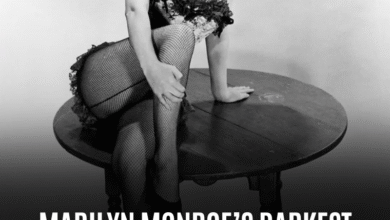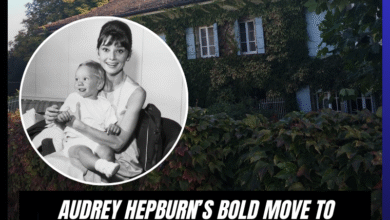Lost, Found, and Sold for $5.6 Million: The Incredible Journey of Marilyn Monroe’s White Dress!
OPINION: This article may contain commentary which reflects the author's opinion.
Marilyn Monroe’s white dress from The Seven Year Itch (1955) has become one of the most enduring symbols of Hollywood glamour and sex appeal, thanks to the unforgettable scene where the wind blows the skirt upwards as she stands over a subway grate. This iconic moment, filmed in 1954, continues to captivate audiences and inspire countless recreations in pop culture. However, the story behind the dress goes beyond its visual impact—it’s also filled with drama, both on and off the set, making it an even more fascinating piece of cinematic history.
Historical Context and Film Background
The dress made its debut in The Seven Year Itch, a comedy directed by Billy Wilder. Monroe stars as a model who becomes the object of affection for her neighbor during a hot summer in New York City. The film, released in 1955, is most famous for its subway grate scene, which was filmed on September 15, 1954, in front of the Trans-Lux 52nd Street Theatre at 586 Lexington Avenue in New York. The scene has since been etched into the public’s consciousness as one of the most iconic moments in film history, cementing Monroe’s legacy as a global sex symbol.
Detailed Description of the Dress
The white dress was designed by William Travilla, a renowned costume designer for 20th Century Fox who collaborated with Monroe on several of her films. The dress is made from rayon-acetate crepe, known for its light and flowing texture, and features a bias-cut design that enhances its ability to billow in the wind.
Key features of the dress include:
-
A halter neckline with a plunging front, exposing Monroe’s arms, shoulders, and back.
-
Sunburst pleats on the skirt, which reaches mid-calf or below, creating a dramatic effect when caught by the wind.
-
A slim belt with a neat bow at the waist, adding structure and definition.
-
Practical elements like a zipper at the back of the bodice and tiny buttons at the back of the halter.
Travilla, in describing the dress, emphasized its contrast with the urban setting of New York, calling it “cool and clean, in a dirty, dirty city.” The dress is often described as ecru or light-colored ivory, with Debbie Reynolds, who later owned the dress, commenting on its age, noting it was “very, very old.”
Behind-the-Scenes Drama and Filming Challenges
The filming of the subway grate scene was not without its complications. The scene was shot in the early hours of September 15, 1954, and attracted a massive crowd of fans and photographers, mostly male, who were encouraged by Fox to create publicity. The crowd’s enthusiasm, combined with their shouts of “higher” to encourage the wind to lift Monroe’s skirt more dramatically, created chaos on set. The scene had to be reshot later at a studio lot in California due to the disruption caused by the crowd’s size.
Off-camera drama also played a role in the scene’s production. Monroe’s then-husband, baseball legend Joe DiMaggio, was present during the filming and reportedly disapproved of the scene’s suggestive nature. DiMaggio’s visible discomfort with the situation, often described as a “look of death,” led to a heated argument between the couple that night at the St. Regis Hotel. Photographs captured DiMaggio storming off the set, and just weeks later, their divorce was announced. The headlines from The Daily News read, “Marilyn Splits With Joe Over Sexy Pictures,” highlighting the personal tension that accompanied this iconic moment in Monroe’s career.
The filming also involved some wardrobe choices that added to the preparation drama. Monroe reportedly wore two pairs of white underwear during the scene, a detail that further added to the behind-the-scenes complexity.
Post-Film Journey and Auction
Following Monroe’s death in 1962, the dress was kept by Travilla, who locked it away. After Travilla’s death in 1990, the dress was displayed by Bill Sarris and later became part of Debbie Reynolds’ collection at the Hollywood Motion Picture Museum. In 2011, Reynolds auctioned the dress at Profiles in History, where it sold for an astounding $4.6 million, with a total cost of $5.6 million after commission, far surpassing expectations. This sale made the dress one of the most expensive pieces of movie memorabilia ever sold, as reported by Guinness World Records.
Cultural Impact and Legacy
The lasting influence of Monroe’s white dress on popular culture cannot be overstated. Its iconic status has led to numerous recreations and references in film, television, and fashion. Films like Shrek 2 (2004), Blades of Glory (2007), and The House Bunny (2008) all feature characters donning similar white dresses, paying homage to the famous scene. In 1984, Kelly Le Brock recreated the wind-blown moment in a red dress in The Woman in Red, and more recently, Angelina Jolie wore a white Marc Bouwer dress at the 76th Academy Awards, widely seen as a nod to Monroe’s enduring influence.
The dress continues to be celebrated for its symbolic and cultural significance, with Glamour magazine even classifying it as one of history’s most famous dresses. A 2014 survey by Cancer Research UK voted it as one of the top 10 most iconic dresses of all time, ensuring its place in fashion history.
Conclusion
Marilyn Monroe’s white dress from The Seven Year Itch is more than just a piece of fashion history; it is a symbol of the complexities of her career, her personal life, and the way in which her image was crafted, scrutinized, and celebrated. The behind-the-scenes drama surrounding the dress, from the chaos on set to the tensions with Joe DiMaggio, only adds to the mystique of this iconic moment in cinematic history. As both a piece of fashion and a cultural artifact, the dress continues to captivate and inspire, ensuring Monroe’s legacy as an enduring Hollywood legend.



